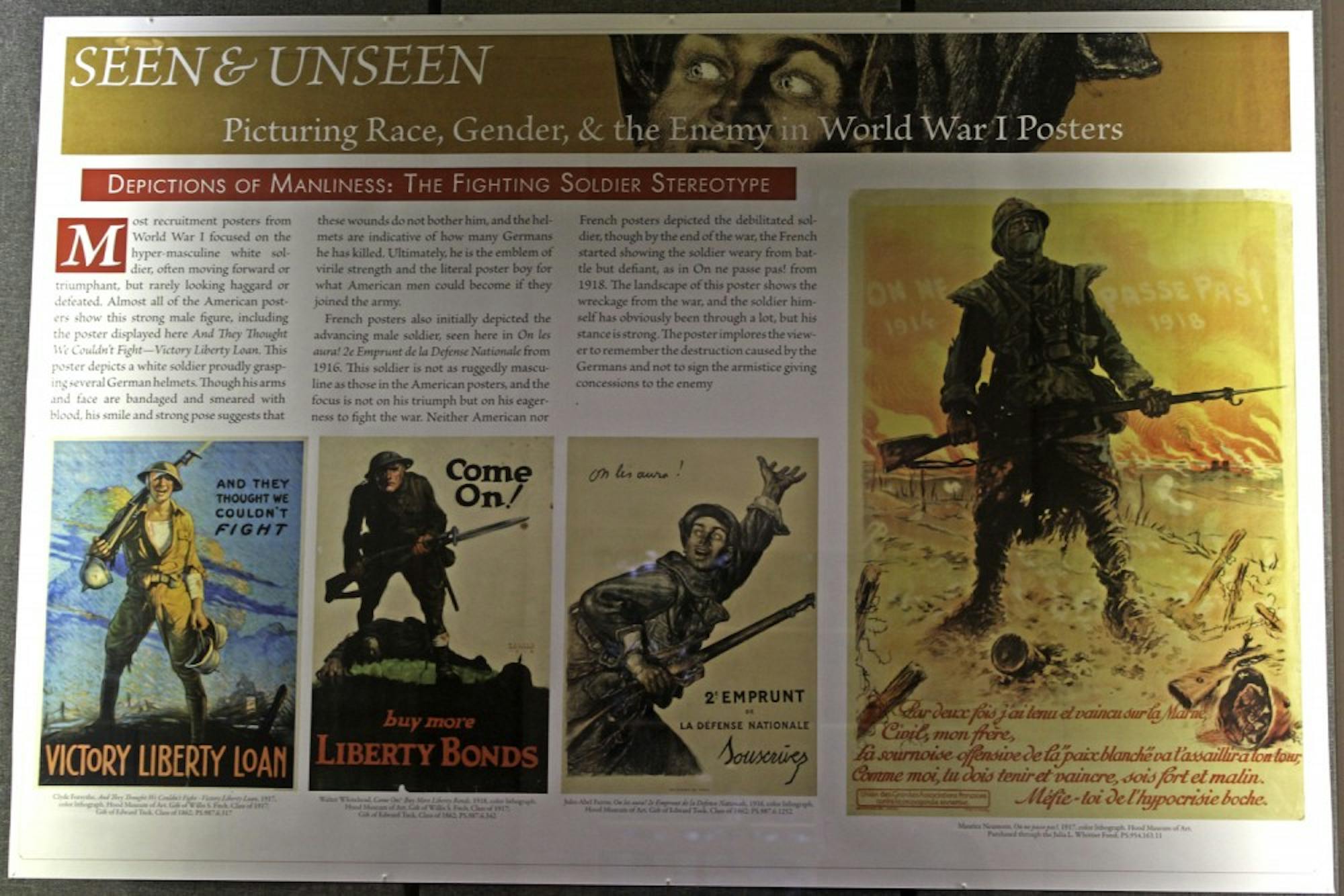Despite Baker Library’s notorious bustle, one cannot help but stop and notice the flashy graphics of World War I posters featured in glass cases along the entrance lobby’s walls. Behind the glass pane, a war-torn figure stands defiant amidst the blaze of a flaming battlefield. In another image, a soldier steps over the corpse of a fallen enemy. Above him, two words capture his unbroken will: “Come On!”
Hood Museum student curatorial interns Sara Trautz ’15 and Winnie Yoe ’14 selected the posters, part of an exhibition called “Seen and Unseen: Picturing Race, Gender and the Enemy in WWI Posters.” The show commemorates the Great War’s 100th anniversary.
The installation contains posters from American, English, German and French collections. Hood curator Katherine Hart said the library display uses only a fraction of the Hood’s nearly 1,200 World War I posters.
“The issue of how to confine such an expansive period of history into such a small space seemed like a good opportunity for a student project,” said Amelia Kahl, the Hood coordinator of academic programming. “[It] challenges the interns to work with our collection in new and different ways.”
Trautz and Yoe chose pieces they believed were emblematic of the time period. They then developed a thesis to link them together, deciding they wanted to convey “what isn’t shown” in classic World War I posters, Trautz said. They focused on the disconnect between “how groups of people were depicted in the posters and how that was different from reality,” she said.
According to the interns’ curatorial statement, the installation chiefly examines five themes: masculinity, women, the enemy, victims and race. Trautz said she and Yoe contrasted these advertisements with images from the war itself, many of which they acquired from the Library of Congress to emphasize the disjuncture and inspire viewers to think more critically about the war.
“The posters give you a sense of the immense range of issues in the war as a mode of mass communication that we don’t really have anymore today,” history professor Margaret Darrow said.
Darrow said that World War I inaugurated the “era of poster advertising,” as this period marked the emergence of brand-name products and the use of public transportation as an advertising forum. Illustrated information aimed to engage civilians in the war initiative by increasing morale, recruiting soldiers, acquiring resources and appealing to women, Darrow said.
“Advertising is so prevalent in our lives today ... it is important to look at imagery that sold and promoted the war, and to see how people were [influenced] to believe in a cause from a visual point-of-view,” Hart said.
These eye-catching mediums, Trautz said, are more approachable and attract a wider audience than text, which can often be daunting to comprehend.
Darrow agreed, adding that visual posters are mainly employed to affect a viewer’s emotions, not to provide concrete information. These posters, for example, often depicted a “demonized” enemy and battered war victims to convince viewers to join the war effort, she said.
“You don’t have to read the captions to get the point,” she said. “The posters speak for themselves.”
The exhibit comprises digital reproductions of the Hood’s works. Library exhibition designer Dennis Grady said the originals could not be displayed due to climate conditions in Baker Lobby.
This also gave the teams flexibility with the posters’ layout and scaling.
“This exhibit talks about issues that are still relevant today — how gender is depicted, how masculinity is depicted,” Grady said.
Hart and Kahl described World War I as a cataclysmic and formative event for Europe that has an influence that continues to loom large in current events. They believe that these posters can remind students of the war’s immense historical significance.
More specifically, Darrow cited the breakup of the Ottoman Empire as an event that still affects Middle East relations today.
“World War I is an important part of our history and something we don’t get to see very often,” Trautz said. “The images really affected public opinion 100 years ago and continue to do so today.”
The exhibition will run through Dec. 19.




